The Apple iPhone 6s and iPhone 6s Plus Review
by Ryan Smith & Joshua Ho on November 2, 2015 8:00 AM EST- Posted in
- Smartphones
- Apple
- Mobile
- SoCs
- iPhone 6s
- iPhone 6s Plus
System Performance Cont'd
Moving on towards our more GPU-bound workloads, we use our standard test suite of benchmarks like GFXBench and 3DMark to get a good idea for performance. Unfortunately, due to the move to iOS 9 the Unity engine version used in Basemark X is no longer working so for now we’re left with 3DMark and GFXBench. There is also Basemark OS II’s graphics test, but this is embedded in a larger benchmark with CPU and storage performance tests.

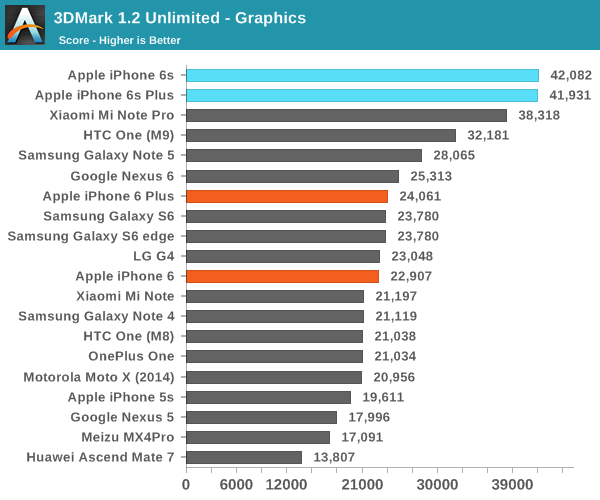
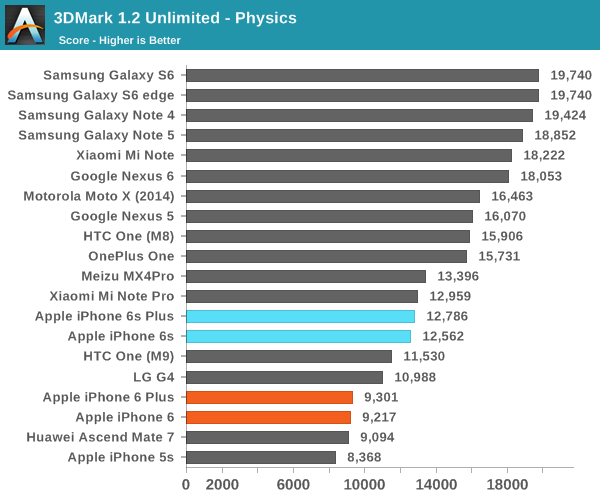
As always with 3DMark, there are some issues in the data structures used. Due to the data dependencies present within the physics test, it is necessary for the CPU to stall for data to be committed to memory before continuing on to the next portion of the test instead of executing instructions in parallel. This strongly reduces the practical performance of the CPU because the architecture is primarily focused upon instruction-level parallelism to deliver major performance gains. However, due to the strong showing in graphics performance the iPhone 6s’ still manage to take the lead.
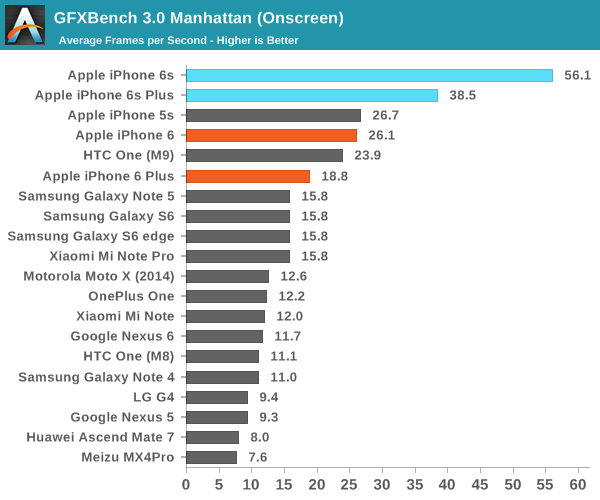
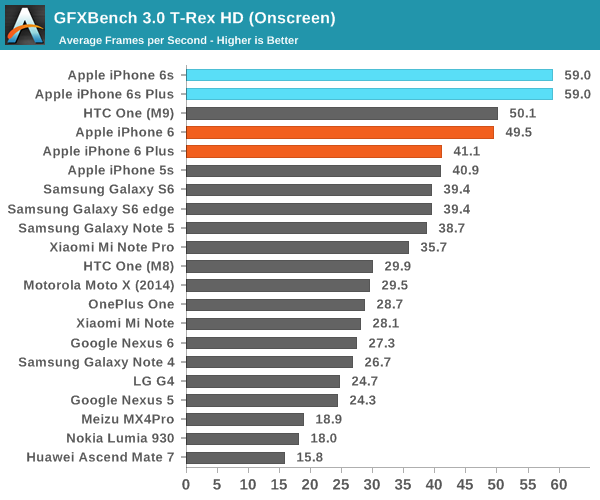
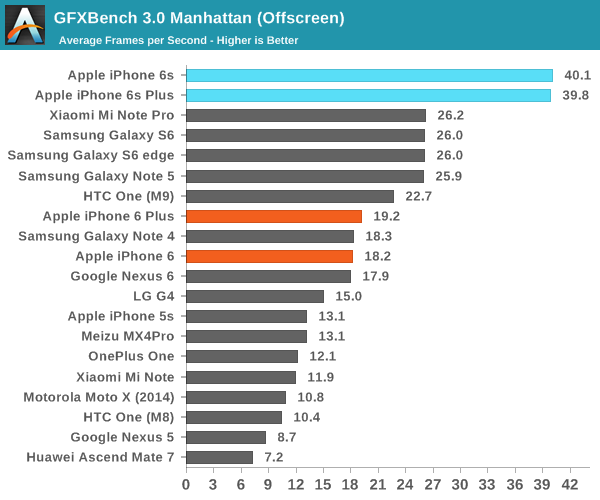

In GFXBench, the A9 SoC just shows absurd performance. It’s strange to think about how the iPad Air 2’s GPU seemed incredibly quick at the time but with the A9 Apple has surpassed that level of performance in their smartphone SoCs. The move to a new generation of PowerVR GPU IP, in addition to the move to a FinFET process node are really the drivers for this kind of performance improvement.
Overall, the Apple A9 SoC is the best SoC in any phone shipping today. In cases like web browsing, gaming, and even just going through the UI it’s quite evident that this new SoC is a major factor in improving performance and smoothness across the board. Something as simple as visiting some popular tech websites will show this, which really goes to show how much “specs” still matter due to their influence on user experience.
NAND Performance
At this point is almost goes without saying that storage performance is important, but in a lot of ways the testing here is still in its early days. In the case of the iPhone 6s we’ve discussed what distinguishes its storage solution from others in this industry, but for those that are unaware the iPhone 6s uses PCIe and NVMe instead of a UFS or eMMC storage solution. In a lot of ways, this makes the storage on board closer to the SSD that you might find in a more expensive PC but due to PCB limitations you won’t necessarily see the enormous parallelism that you might expect from a true SSD. In the time since the initial results we've found that all of our review units use Hynix-supplied NAND. In order to test how this storage solution performs, we use Eric Patno’s storage test which allows for a simple storage test comparable to AndroBench 3.6.
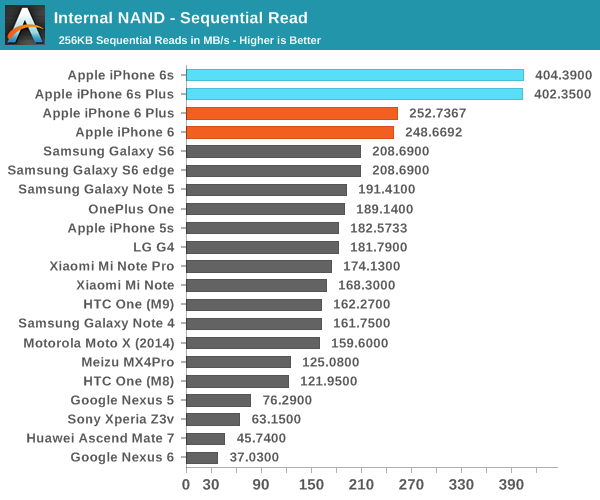
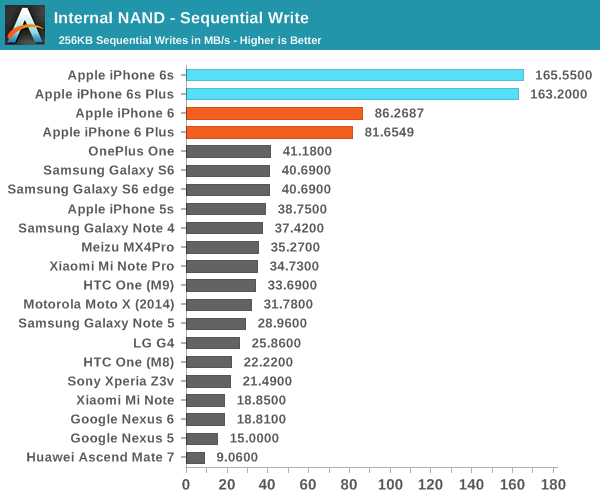
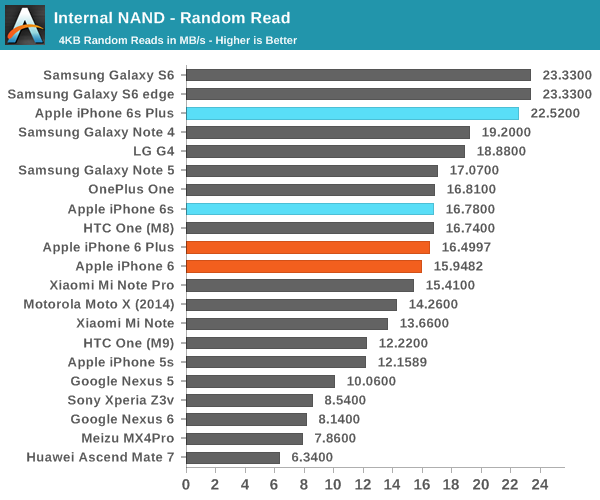
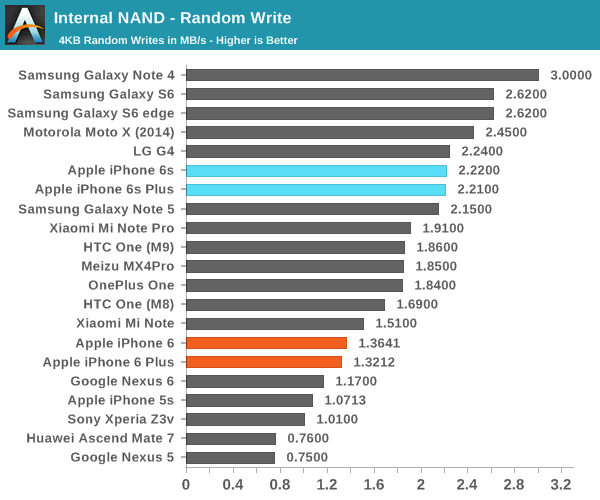
Here, we can really see the enormous performance improvements that result from a combination of TLC NAND with an SLC cache, along with the new NVMe protocol which allows for low CPU overhead and removes architectural bottlenecks to storage performance. This should allow for things like faster burst photos and faster app updates. Downloading and updating apps on the iPhone 6s feels noticeably faster than it is on the iPhone 6, to the extent that small apps feel like they install almost instantly when I’m on a WiFi connection fast enough to saturate storage bandwidth.










531 Comments
View All Comments
nerd1 - Saturday, November 7, 2015 - link
720p screen in 2015, worse battery life, no sd slot, no wiress charging, terrible camera and still THE BEST phone huh?It has best performing processor, no one argues that, but I still wont touch it with a stick.
JaytB1 - Sunday, November 8, 2015 - link
I use iPhone mainly because of the better security/privacy, no carrier/manufacturer delay/total dismissal of security/OS updates, earlier/exclusive/better releases of triple A games/apps and uncluttered interface. I agree with the gold award, the iPhone 6s (plus) is the first phone in a while that made me see that there are still possibilities to innovate in the smartphone space.I've seen Android users avidly defending their high PPI's, megapixels, core counts. Oh, but it's customizable and I can put a ton of widgets on my homescreens. There's only a small minority of tech obsessed people who care (proof is in the huge low/medium end market share, indicating the amount who don't care for specs but just want a working phone). For me, all I want is to launch an app, not stare at my home screen. In the past, Android users where more often than not boasting about benchmarks and how their hardware was superior. Now that the tables are turned, hardware all of a sudden doesn't matter as much anymore or the tests must be rigged by a biased Anandtech (who has nothing to gain and everything to loose if they were posting nonsense).
I've seen Samsung and other manufactures add so many gimmicks to their phones, many of which are plain impractical (try doing 'airview' while jogging and you'll get the picture).
I admit that fast charging would be nice but, for me, completely unnecessary (it's not like an iPhone charges slow in the first place).
Then there's wireless charging, you do realize that you still have to plug in the charge pad with a cable right? So the only difference is that you don't need to plug that cable into your phone, but you'll need more power to fill your device up as compared to using a cable (more waste power) and a permanent spot for your charging pad. Again, for me I don't really see the appeal for that either.
We could also talk about PPI but to keep it brief, I'd rather have a device perform well with individual pixels I can't distinguish, than a screen that would impact performance with pixels I still can't see... But more of them.
I could go on about how a blind photo evaluation test on a respected Android site had Android users voting the iPhone 6s as having the best overall picture quality, but now that the iPhone scored a tiny bit lower than some Android phones in one test, it suddenly has a 'far inferior' camera. Then there's the RAM, curved screens and so many other things I could mention, but my point is that I think Android users can't recognize a genuine game-changing feature-list because they're so used to getting bombarded by tons of arguably useless high spec lists and gimmicks that are marketed as 'the next big thing'.
It's almost as if Google took over the reality distortion field from Apple. Just wait a couple of years when all Android devices have 'Android sense' (or something) displays (3D touch), THEN it will be a game changing feature because they'll have 1000's of pressure levels they can sense as compared to the 'useless' iPhone's (hypothetical) 128 levels.
Don't get me wrong here, I'm not trying to bash Android or people who choose to use it, I just don't like those who post nonsense without anything to back it up just so they can sleep at night having convinced themselves that they bought the right phone. I've been a reader of this site for years and believe their test results to be correct, as they've always been. People who claim otherwise should come with facts or stop sprouting nonsense.
I, for one, agree with the review and think it's the phone with the best all round feature set on the market today. Is it perfect? Of course not, but it's a genuinely forward thinking and exceptional smartphone in a stale smartphone market, and that deserves that gold award in my book.
Thanks for the review!
Aritra Ghatak - Sunday, November 8, 2015 - link
As the reviewers pointed various aberration and distortions associated with using a brighter lens and that it is wise Apple went with the F 1/2.2 aperture lens. Could you please explain how Samsung manages with an F 1/1.9 aperture lens in Galaxy S6? Or for that matter the F 1/1.8 lens in LG G4 or Nokia Lumia 720/730?patamat - Sunday, November 8, 2015 - link
Well, we all know who Anand went to work for after writing few "balanced" reviews like this one.(apple ...)
Psymac - Monday, November 9, 2015 - link
Where is the phone function analysis of this iPhone?zimmybz - Tuesday, November 10, 2015 - link
I guess I'll try to build the bridge for the Droid guys here that are having a hard time.I haven't had an iPhone since the Galaxy S came out. Been a droid user since.
I recently got a 6S Plus. I sold a Note 5 and cancelled a pre-order for a Nexus 6P.
I will say it since nobody else will. The Note 5 has a great camera, S-Pen is cool, and enough RAM to keep multi-tasking running, but otherwise it's a shitty phone. The battery life and Touchwiz still leave a LOT to be desired. Build quality is great, but it suffers from what every other Droid phone suffers from - fractured, fragmented hardware eco-system and specs driven production. (Hang on)
If you need to know why you should cancel a 6P pre-order, look at the subreddit (Holy crap, lol.)
Anyways, in my first week with the 6S Plus, I hit 22% battery with 88 hours standy and 13 hours usage. That is completely insane.
Back to the Note 5 - look at the graphs on the review here. This phone absolutely DOMINATES the Note 5 across the board, a fact which I can confirm first hand.
I can also tell you that holding the phones side by side looking at the same picture taken on the Note 5, the displays are functionally indistinguishable from the other. (So much for all that resolution, I guess)
This is a large reason why the Note stutters against the 6S Plus. It's pushing a LOT of pixels that aren't really evident in day to day use, especially sitting next to the iPhone.
I guess I finally reached the point, I just want the best phone every year regardless of manufacturer or software.
Until Google makes it's own hardware in house and breaks free of QualComm, Apple is going to beat them every year going forward. I'm not 20 anymore, I don't care about a home screen widget. I want the battery not to drain from some stupid Google Play Services memory drain while the phone is sitting on my desk.
I don't want Samsung Services blowing up the battery either. And - NO - I should not have to root kit, Package Disable, Power Saver, Turn off Location, etc, etc, etc. I paid $1000 for a premium handset with lots of features.
Oddly enough, the iPhone can leave all that crap on and STILL get good battery life. The arguments for Android are shrinking right now. I'll never buy another Samsung phone again. I will miss the S-Pen, but Touchwiz is heinous, even in it's current iteration.
I would really love to see Google put up a fight in the premium handset market, but I don't think their hearts are in the hardware QUITE yet.
Anyways, happy 6S Plus user here, 4+ year droid convert at the moment. We'll see what next year brings.
zeeBomb - Wednesday, November 11, 2015 - link
Ss or bs (sorry I just had to)JTRCK - Friday, November 13, 2015 - link
I actually returned a 6S Plus for the Nexus 6P and the main reason was PRICE. They are as equally performant in day to day tasks, but the Nexus 6P had better multitasking performance for me due to the buttons and added power of a side launcher which is not possible on iPhone. I basically never have to go to the home screen again when using Google docs, searching the web, etc... I tried both out for about a week. The only feature I liked on the iPhone 6S Plus better was the cooler white colors of the LCD; other than that the Nexus 6P was better "for me" in every aspect. The phone "flies" in every sense of the word. No stutters, no lag, no unresponsiveness (typical of Samsungs). I have been an iPhone user since the 3GS. I also used the iPhone 6 Plus this year for 5 months.And I truthfully don't understand all this commotion over the new iPhone 6S Plus being the best phone ever released. Outside of "3D touch," there is not much difference in day to day performance or general use between both this year's model and last year's model. That is generally a great testament to iOS stability and performance. So much so that my old iPhone 4s opened apps faster, surfed faster, multitasked faster, etc, than my now defunct Note 4. Apple has been on top of their game for years, IDK why android fans have only now noticed. But iOS is truly very limited. You will sooner or later find out the gates keep you truly locked in.
But the main factor for me, again, was price. I do not in any way find the iPhone to be a better phone than the Nexus 6P. In fact, I find its system to be inferior in a multitude of ways. Is the iPhone Better than the Note 5 and all its clumsy and useless features? Yes. But the Nexus 6P is in a category all its own. Especially for $650. That is exactly what I paid for the 128GB model compared to the $1,170 I paid for the iPhone 6S Plus.
astroboy888 - Wednesday, November 11, 2015 - link
"FinFET transistors are necessary because as transistors get smaller their leakage (wasted power) goes up, and without FinFETs leakage would spiral out of control. In fact that’s exactly what happened on the 20nm nodes from Samsung and TSMC; both companies thought the leakage of planar transistors could be adequately controlled at 20nm, only for leakage to be a bigger problem than they expected"It is not they "discovered" 20nm leakage was high; therefore they switched to 16nm FinFet. This is an incorrect comment.
FinFet transistors structure had been on the road map and in development at TSMC for more than 10 years. TSMC's first finfet transistor was demonstrated in 2002 when the inventor Professor Chen-Ming Hu of UC Berkeley was working at TSMC as CTO. Therefore Finfet process had always been on the roadmap for 16nm process. The 20nm planar process had always been on the road map as a planar process. Every process node takes about 3-5 years to develop, so the customers (semiconductor chip designers) signs up 3-5 years before hand to co-work with TSMC to design a chip for that process. These were communicated ahead of time and contracts where signed.
In the late 1990s and early 2000s, the semiconductor industry was pushing for SOI (Silicon On Insulator such as GaAs "Gallium Arsenide), which completely eliminates leakage current. But the transistor performance turned out to be too unpredictable and too expensive to manufacture. Therefor the industry stuck with silicon, until FinFet structure was invented in 2000 and manufacturing process perfected some 10 years later.
gonsolo - Thursday, November 12, 2015 - link
If I may suggest something: I'd like to see app startup times as a benchmark from iPhone 5 onwards. This is something I'm doing a lot; waiting for apps to start.